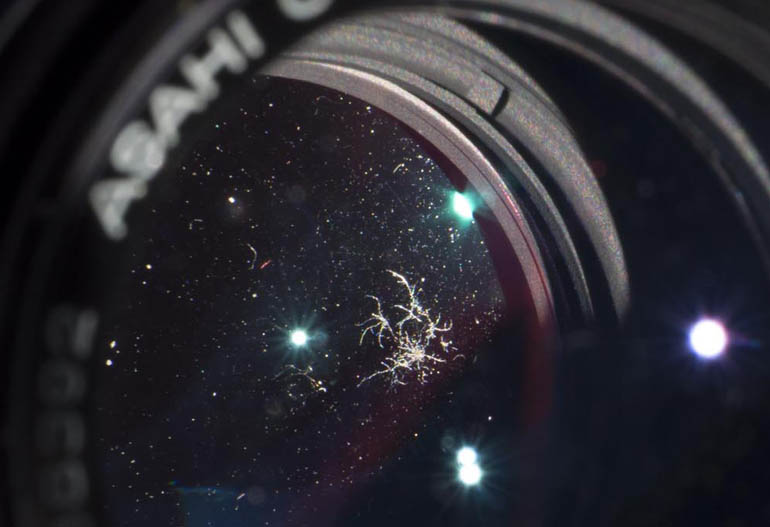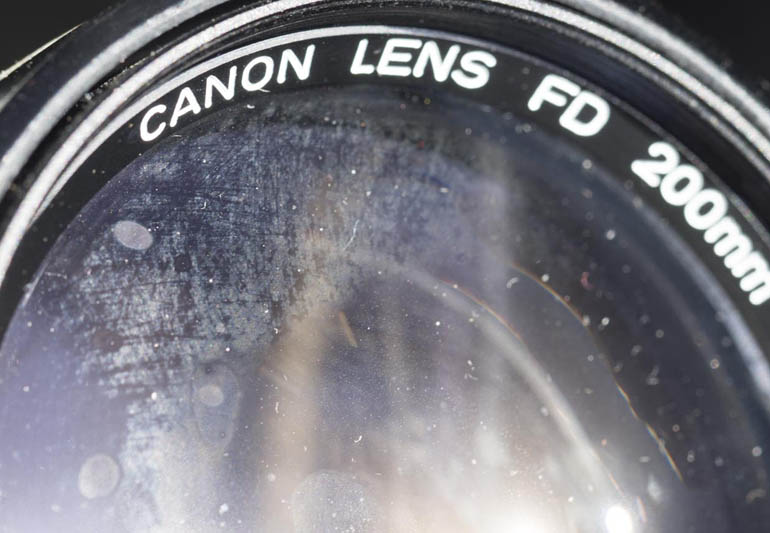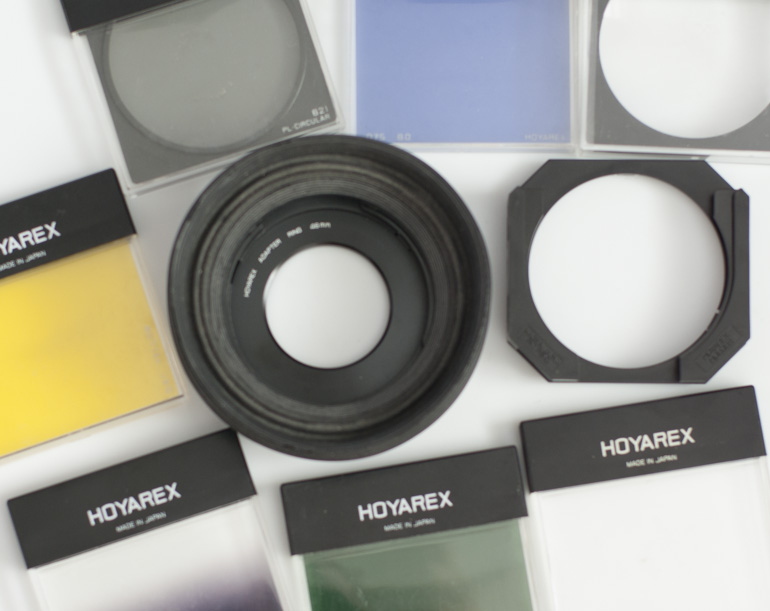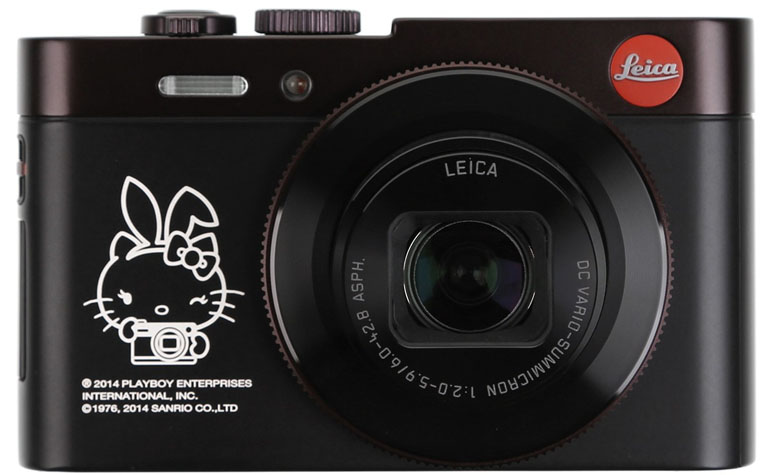A Kickstarter project has been set up to fund the production of Polaroid New55 FILM – an instant peel-apart 4x5in film that produces a negative and a positive print.
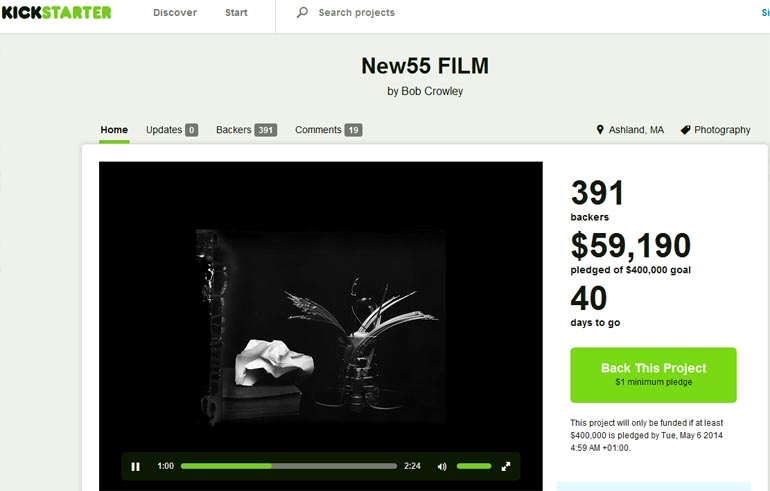
Bob Crowley, innovator, product manufacturer and developer, is the founder who started research on the film three years ago and has now brought the project to Kickstarter for funding. A goal of $400,000 has to be raised between Mar 23 2014 – May 6 2014. At the time of writing, 3 days in with 40 days to go, the project has already raised 15% of the total amount required.
All contributors to the New55 FILM Kickstarter project at the higher reward levels, will receive boxes of New55 FILM “First Edition” (5 sheets per box).
A filter factor is highlighted on many filters as a multiple (or x). It’s simply the amount you need to increase the exposure by to compensate for light absorbed by the particular filter being used.
x2 is a one stop increase
x4 is two stops
x8 is three stops
x16 is four stops
If, for example, you have a x4 orange filter on the lens, the exposure has to be increased by four times – that is two full f/stops or shutter speed increments.
Lets say you have an exposure of f/5.6 (aperture) and 1/125sec (shutter speed) and add the x4 filter. You would either have to adjust the aperture two stops to f/2.8 or the shutter speed two stops to 1/30sec or both one stop so the exposure would be f/4 at 1/60sec.
Fortunately with modern through-the-lens (TTL) metering and automatic cameras the filter factor is taken care of, but you need to make the necessary adjustments when using manual cameras or manual exposure with flash.
To make things a little more complicated, some filters, such as the polariser, have variable exposure factors as you rotate the filter, and others have incremental factors such as 1.3x which makes it hard to adjust if you have an older camera with only full stop increments.
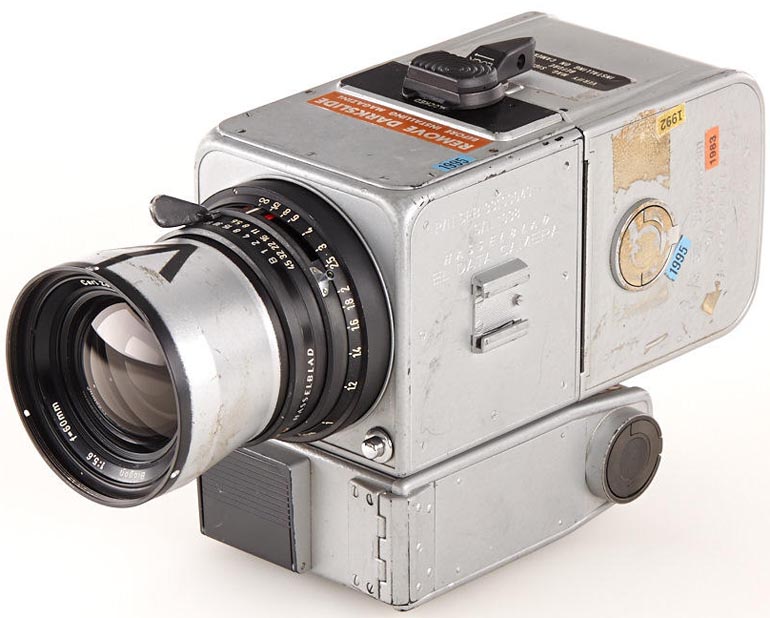 Mr Fujisawa, founder of Japanese photography retail chain Yodobashi Camera, has just won a Hasselblad Lunar Module Pilot camera at the 25th WestLicht Camera Auction. The camera, a Hasselblad 500 EL data, was used by Jim Irwin to take 299 photos on the Moon while on the Apollo 15 mission between July 26th to August 7th, 1971. With a start price of 80,000 Euros It was expected to fetch up to 200,000 Euros , but after a close bidding war reached 682,000 Euros (over half a million quid!)
Mr Fujisawa, founder of Japanese photography retail chain Yodobashi Camera, has just won a Hasselblad Lunar Module Pilot camera at the 25th WestLicht Camera Auction. The camera, a Hasselblad 500 EL data, was used by Jim Irwin to take 299 photos on the Moon while on the Apollo 15 mission between July 26th to August 7th, 1971. With a start price of 80,000 Euros It was expected to fetch up to 200,000 Euros , but after a close bidding war reached 682,000 Euros (over half a million quid!)
Details of the 25th WestLicht Camera Auction here.
Fungus spores are everywhere, but they only germinate in humidity and they thrive on dust.
A lens that has a dose of fungus has it because it has dust inside (and all lenses have some specs of dust even if they’re hard to see), and it’s been kept in a humid/warm environment. Fungus likes dark, damp places with warmth. Fungus generates spores which look to feed on dust, but the amount of dust in most lenses isnt enough for the fungus to spread.
When you clean a lens you move the dust around and push it into the edges. If the lens is then stored in a humid environment it’s more likely to encourage fungus growth. The fungus wont spread from lens to lens but it may appear in other lenses if the conditions are right for it.
So it’s best to store your lenses in a dry place in good light with minimal humidity. Also use them – the UV in sunlight kills fungus.
The above photo shows one patch of familiar fungal veins. This is on a rear element and is hard to spot without scrutiny.
The best way to check for fungus is to shine a bright light in through the front or rear. A mini torch such as a Maglight is ideal.
Can fungus spread from camera lens to lens?
Does lens fungus spread from one lens to another? It’s a common question. Much is written about the subject on the internet…and views are mixed – some saying yes it does spread so you should isolate the infected lens and some say no, don’t worry about it.
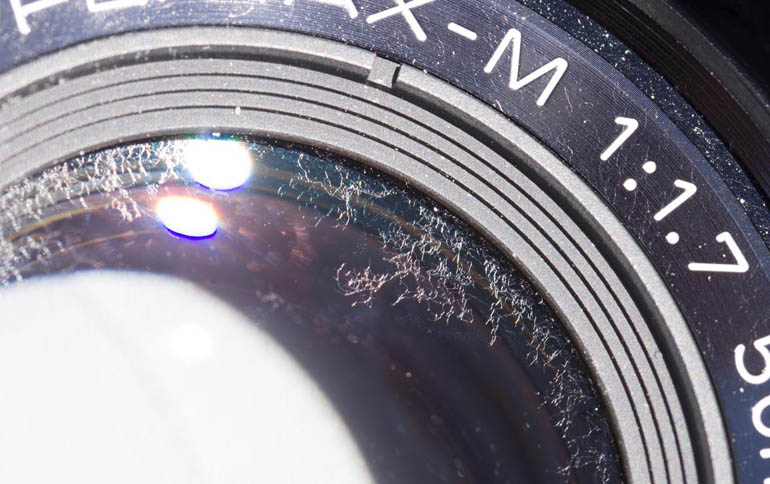 This lens has lots of fungal attack ont the front element that’s creeping out to the centre. At present this could be used without any real loss in quality.
This lens has lots of fungal attack ont the front element that’s creeping out to the centre. At present this could be used without any real loss in quality.
Using infected lenses
You can often clean fungus off the lens elements providing it’s not etched into the coating. If it’s on the inner elements you’ll need to strip the lens down but only attempt that if you’re competent with mechanical items as they’re not always as simple to take apart as they look.
If the lens is stored well once fungus is found it’s unlikely to spread.
Lenses can be used and results will vary depending on the level of contamination. A small colony here or there is hardly likely to affect anything while a more severe case will cases a dramatic reduction in contrast and sharpness, especially when shooting into the sun.
This lens is badly affected and will result in lower contrast photos that lack sharpness and have a diffused look.
For those who want more info check out this informative web page: All about lens fungus
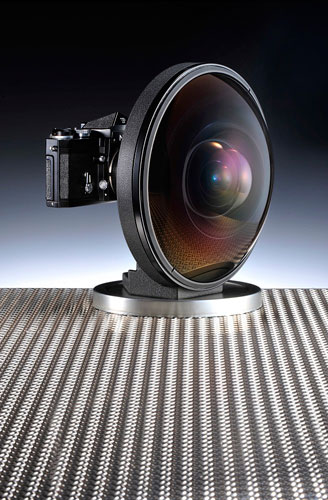 Back in April 2012 Grays of Westminster sold the ultra rare Nikon 6mm f/2.8 fisheye lens for £100,000
Back in April 2012 Grays of Westminster sold the ultra rare Nikon 6mm f/2.8 fisheye lens for £100,000
The 220º Nikkor fisheye lens weighs 5.2kg, measures 171mm in length and has a diameter of 236mm. It’s one of the few 220º Nikkor fisheye lenses ever to be made.
Last week another one turned up on ebay : Nikon 6mm Fisheye on eBay
This one failed to reach the $49,500 dollar reserve (approx £30k), which compared with the previous sale price was an absolute bargain.
Even so is any lens really worth this kind of price tag? Would you pay this kind of money for a lens?
We have lots of low cost camera lenses for sale here
Hoyarex filters were arguably the best filter system made. Optically superb, several made from glass, solid filter holder, brilliant adjustable rubber hood for wide or super telephoto, and a useful range of filters.
Hoyarex was a filter system developed by Hoya. Hoya was the big name in optical filters and then French manufacturer Cokin appeared with a system that would revolutionise the filter world.
Hoya reacted fast but not fast enough. Cokin had soon taken hold of the filter market with serious and special effect filters. Photographers were no longer buying one or two filters they were investing in cases full.
The Hoyarex system emulated what Cokin had done, but in our opinion did it better, some filters were glass, others had frames around them so handling was better. The holder was more flexible and had a more versatile lens hood. The filters slotted in more comfortably and the adaptors clipped in easier.
But they were too late and Cokin won the battle. Hoyarex disappeared as quick as they came.
You can still find remnants of the system sold in the second-hand sections of various photographic retailers, and there are many here on PhotographyAttic.
The illustration above shows the filter holder with an adaptor ring (available in sizes from 43mm up to 77mm) and the wonderful rubber Pro hood that clipped on the holder and had a variable extension.
Two filter holder can be clipped together and rotated when special effect filters were inserted.
Here in numeric order is the entire range with links to buy individual used filters at photographyattic.com
| Filter model | More info | Buy |
| Hoyarex 011 Skylight 1B | Skylight 1B | Hoyarex 011 |
| Hoyarex 021 UV | UV Filters | Hoyarex 021 |
| Hoyarex 031 Sepia | Hoyarex 031 | |
| Hoyarex 041 Yellow | Hoyarex 041 | |
| Hoyarex 042 Orange | Hoyarex 042 | |
| Hoyarex 043 Red | Hoyarex 043 | |
| Hoyarex 044 Green | Hoyarex 044 | |
| Hoyarex 052 NDx4 | ND Filters | Hoyarex 052 |
| Hoyarex 061 81 Warm | Hoyarex 061 | |
| Hoyarex 065 85 Orange | Hoyarex 065 | |
| Hoyarex 071 82 Blue | Hoyarex 071 | |
| Hoyarex 075 80 Blue | Hoyarex 075 | |
| Hoyarex 081 FL-Day Magenta | Hoyarex 081 | |
| Hoyarex 121 Soft Spot | Hoyarex 121 | |
| Hoyarex 131 Soft Spot G (Grey) | Hoyarex 131 | |
| Hoyarex 132 Soft Spot B (Blue) | Hoyarex 132 | |
| Hoyarex 136 Mist Spot E | Hoyarex 136 | |
| Hoyarex 138 Mist Spot O | Hoyarex 138 | |
| Hoyarex 139 Mist Spot R | Hoyarex 139 | |
| Hoyarex 152 Splitfield | Hoyarex 152 | |
| Hoyarex 161 Technical Mask | Hoyarex 161 | |
| Hoyarex 162 Black Plain Mask | Hoyarex 162 | |
| Hoyarex 171 Vignetter | Hoyarex 171 | |
| Hoyarex 181 Double Mask | Hoyarex 181 | |
| Hoyarex 182 Dual Image | Hoyarex 182 | |
| Hoyarex 212 Fog 2 | Hoyarex 212 | |
| Hoyarex 216 Fog Half | Hoyarex 216 | |
| Hoyarex 222 Diffuser 2 | Hoyarex 222 | |
| Hoyarex 242 Softener (A) | Hoyarex 242 | |
| Hoyarex 243 Softener (B) | Hoyarex 243 | |
| Hoyarex 324 Star 4 | Hoyarex 324 | |
| Hoyarex 326 Star 6 | Hoyarex 326 | |
| Hoyarex 328 Star 8 | Hoyarex 328 | |
| Hoyarex 413 Multivision 3 | Hoyarex 413 | |
| Hoyarex 415 Multivision 5 | Hoyarex 415 | |
| Hoyarex 521 Gradual G2 | Hoyarex 521 | |
| Hoyarex 522 Gradual B2 | Hoyarex 522 | |
| Hoyarex 523 Gradual T2 | Hoyarex 523 | |
| Hoyarex 524 Gradual M2 | Hoyarex 524 | |
| Hoyarex 525 Gradual P2 | Hoyarex 525 | |
| Hoyarex 526 Gradual E2 | Hoyarex 526 | |
| Hoyarex 527 Gradual Y2 | Hoyarex 527 | |
| Hoyarex 611 Linear Polariser | Hoyarex 611 | |
| Hoyarex 621 Circular Polariser | Hoyarex 621 | |
| Hoyarex 702 Diffraction 2x | Diffraction filters | Hoyarex 702 |
| Hoyarex 704 Diffraction 4x | Diffraction filters | Hoyarex 704 |
| Hoyarex 708 Diffraction 8x | Diffraction filters | Hoyarex 708 |
| Hoyarex 718 Diffraction 18x | Diffraction filters | Hoyarex 718 |
| Hoyarex 736 Diffraction 36x | Diffraction filters | Hoyarex 736 |
| Hoyarex 748 Diffraction 48x | Diffraction filters | Hoyarex 748 |
| Hoyarex 799 Diffraction Halo | Diffraction filters | Hoyarex 799 |
| Hoyarex 811 +1 | Hoyarex 811 | |
| Hoyarex 812 +2 | Hoyarex 812 | |
| Hoyarex 813 +3 | Hoyarex 813 | |
| Hoyarex 814 +4 | Hoyarex 814 | |
| Hoyarex 911 Gelatine Filter Holder | Hoyarex 911 | |
| Hoyarex 912 Universal holder | Hoyarex 912 | |
| Hoyarex 921 Lens Shade | Hoyarex 921 |
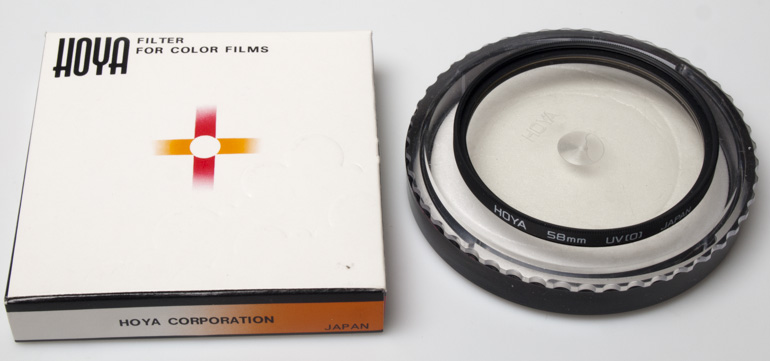
The Multi-purpose UV is similar to the skylight, absorbing the ultraviolet rays which often make scenic shots hazy and indistinct. Moreover, the UV, especially when used with black & white film, increases contrast, reduces haze and generally improves the “sharpness” of your photographs
Many photographers buy a UV filter for each lens and leave them screwed on to protect the lenses’ front elements.
UV filters are available in round type that screw into the lens in ever size imaginable.
They were also made by Hoyarex for their square filter system.
Links to buy
Hoyarex 021 Filter
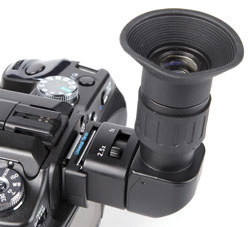 Unless you’re lucky enough to have chosen a camera with a tilting /hinged screen taking photos from ground level can be very uncomfortable or awkward. The titling screen feature on certain digital cameras allows you to view and compose from a height by looking down on the screen that is angled upwards.
Unless you’re lucky enough to have chosen a camera with a tilting /hinged screen taking photos from ground level can be very uncomfortable or awkward. The titling screen feature on certain digital cameras allows you to view and compose from a height by looking down on the screen that is angled upwards.
This makes the camera easy to use when shooting flowers and fungi or other similar subjects from ground level.
Many of us don’t have such luxury feature, but there is an option available if your camera has a viewfinder with a slide in eye cup frame. The right angle finder slips over the viewfinder in place of the eye cup and provides an optical path set at 90 degrees. so you look down into the viewfinder. It still means you have to bend down to see, but at least it’s from a more convenient angle.
Many right angle finders also have built in diopter correction so they’re prefect for those of us with glasses. And some even have a built in magnifier going from standard 1x view to a cropped 2x or even 2.5x view. This is great focusing aid as you can be sure your subject is in perfect focus.
Finders are usually sold by the camera manufacturer, but there are also several available from accessory manufacturers. They’re not quite as popular as they used to be but there’s plenty around on eBay and we have several on PhotographyAttic – Right Angle Finders and Viewfinder attachments. You need to choose one that fits your camera’s viewfinder as each brand can be slightly different. Check before buying.
The Parisian concept store Colette has sold out of the very limited Hello Kitty Playboy branded Leica camera. Stalwart Leica fans might have been horrified that their upper crust brand had been tarnished with a cartoon character and a price tag of £750. Only 10 were sold, so perhaps Colette thought is was a risk to jump in with bigger quantities.
What do you think? Is the cartoon something more suited to plastic toy cameras or, being an iconic character, did it deserve place on such a prestigious brand that has, over the years, usually been reserved for some form of exotic animal skin.
ePHOTOzine’s tech editor Josh Waller was covering the Photography Show at the NEC Birmingham – full report here Photography Show 2014 show guide
The guide includes previews of the following new cameras
Nikon Coolpix P340, the 30x optical zoom Nikon Coolpix S9700, Nikon Coolpix P60 and waterproof Nikon Coolpix AW120.
Canon Powershot SX700HS, SX600, N100, D30 and IXUS 265.
Samsung WB2200F
Canon’s EOS 1200D entry level Digital SLR
Canon Powershot G1 X Mark I
Panasonic Lumix GH4
Nikon D4s
They also looked at the following lenses:
Zeiss OTUS 55mm f/1.4 lens and Zeiss Touit 50mm f/2.8 macro lens for Sony NEX E-Mount and Fujifilm X-Mount cameras.
Panasonic Leica DG Summilux 15mm f/1.7 ASPH. lens
Tokina 11-16mm T3.0 (f/2.8) for APS-C cameras and the 16-28mm T3.0 (f/2.8) lens for full-frame cameras.
Tamron 16-300mm 18.8x optical zoom lens for APS-C cameras, as well as the 28-300mm full frame lens.
Fujifilm Fujinon XF 56mm f/1.2 R lens for Fujifilm X cameras.
Kowa Prominar Micro Four Thirds 8.5mm f/2.8, 12mm f/1.8, and 25mm f/1.8 lenses
The Photography Show, organised by Future Publishing, replaces Focus on Imaging and is the UK’s largest photography exhibition. From feedback it seems as though the first of these shows was a huge success.
UPDATE 24 December 2025:
Latest Products
Blog Categories
- Buying Guides (18)
- Cameras (6)
- Events (5)
- Filters (19)
- Flash (3)
- Lenses (10)
- News (7)
- Observations (5)
- Photography Techniques (10)
- Tips (16)
- Uncategorized (2)
Latest Articles
‣ Guide to photographing the NORTHERN LIGHTS‣ Nikon AF Micro-Nikkor 70–180mm f/4.5–5.6D ED
‣ A Practical Guide to Cross-Polarisation Photography
‣ Nikon Noct-NIKKOR 58mm f/1.2
‣ Guide to the Metz Flashgun SCA Modular System
